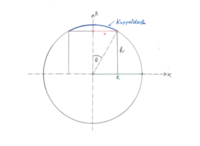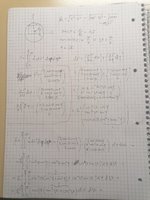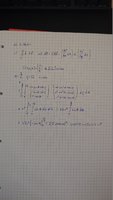Hello everyone, so this is an example from a physics calculus exam that I'm working through and I would really need some help setting up the entire thing, since I'm very confused as to how am I even going to start this example. I am even confused as to what some of the specific parameters are - like n̂. Any kind of help would be useful!
The example is in german so I tried my best to translate it as clearly as possible (including the notation for surface):
"You are working on a project in which a building will have a glass-dome roof built on top. The building itself is cyllindrical with a radius of r=50 m and a height of h. The dome represents a circle segment of a sphere which has a radius R = 100 m. ....edited (see picture)

a) Calculate the height h
b) You are asked for the requiered amount of glass needed. Therefore calculate the surface of the dome.
Hint: Calculate in spherical coordinates. In general it applies:
[MATH]A = \int_{0}^{\vartheta }\int_{0}^{\varphi }\hat{n}\cdot \mathrm{d}\vec{\sigma }[/MATH]
where n̂ is the unit normal vector to the given surface. The vectorial surface element dσ is given as:
[MATH]\mathrm{d}\vec{\sigma }=\hat{n}\mathrm{d}\vec{\sigma }=\left ( \frac{\partial \vec{r}}{\partial \vartheta }\mathrm{d}\vartheta \right )\times \left ( \frac{\partial \vec{r}}{\partial \varphi }\mathrm{d}\varphi \right )[/MATH]"
I am certain you can calculate the height very simply (that is worth only 1 point and the integral is 5 points) even though I currently can't even think of how to do that. Thank you in advance.
The example is in german so I tried my best to translate it as clearly as possible (including the notation for surface):
"You are working on a project in which a building will have a glass-dome roof built on top. The building itself is cyllindrical with a radius of r=50 m and a height of h. The dome represents a circle segment of a sphere which has a radius R = 100 m. ....edited (see picture)

a) Calculate the height h
b) You are asked for the requiered amount of glass needed. Therefore calculate the surface of the dome.
Hint: Calculate in spherical coordinates. In general it applies:
[MATH]A = \int_{0}^{\vartheta }\int_{0}^{\varphi }\hat{n}\cdot \mathrm{d}\vec{\sigma }[/MATH]
where n̂ is the unit normal vector to the given surface. The vectorial surface element dσ is given as:
[MATH]\mathrm{d}\vec{\sigma }=\hat{n}\mathrm{d}\vec{\sigma }=\left ( \frac{\partial \vec{r}}{\partial \vartheta }\mathrm{d}\vartheta \right )\times \left ( \frac{\partial \vec{r}}{\partial \varphi }\mathrm{d}\varphi \right )[/MATH]"
I am certain you can calculate the height very simply (that is worth only 1 point and the integral is 5 points) even though I currently can't even think of how to do that. Thank you in advance.
Last edited by a moderator:



